A sure sign of spring is the beautiful sound of songbirds singing in the morning sun!
Songbirds, also known as passerines, belong to a large suborder of perching birds that equate to about half of the birds on earth. Many songs are beautiful, some seem demanding, but all are ways of communicating for birds within species.
The five general categories of bird language are:
Songs – signature sound to defend territory and attract mates
Companion calls – sound to communicate with each other
Juvenile begging – the “I’m hungry” call from chicks
Aggression – used to defend territory against intruding birds
Alarm – sound to warn other birds to a threat
Some common families of songbirds are sparrows, finches, wrens, thrushes, tanagers, and larks.
What songbirds can I find in Bridle Trails?
There are many songbirds in the lowland forests of Washington State. In our park you can find many, including vireos, swallows, chickadees, bushtits, wrens, kinglets, thrushes, warblers, tanagers, towhees, sparrows, juncos, grosbeaks, finches, crossbills, waxwings, creepers, swifts, and siskins. More information on a few of our songbirds can be found below and a complete list of birds in the park is on our Natural History page.
Dark-eyed Junco
One of the area’s most common songbird species in many neighborhoods, also in the park. In yards, they often nest in planters. Juveniles are streaky like many other sparrows, but all have white outer tail feathers conspicuous in flight. Year-round resident.
Bushtit
Plain grey-brown and tiny, with no distinct song. Roost and feed close together in groups of 10-40 and have hanging nests. Year-round resident.
Swainson’s Thrush
A migrant, arriving in May to nest in the park. Lovely upward-spiraling, flute-like song can be heard in the park.
Black-Capped Chickadee
Common in neighborhood yards and in the park. Nests in holes in trees (or bird houses) to protect the eggs and young. Most common call is the easy-to-hear “chickadee-dee-dee”. Year-round resident.
Song Sparrow
Common in neighborhood yards and often seen in the park, feeding in shrubs and on the ground for seeds and insects. Distinctive song “match, match, tea kettle kettle put it on.” Year-round resident.
Pacific Wren
Small and mouse-like, hangs out in the forest understory looking for insects. The amazingly loud, long, and liquid song of this year-round resident bird is often heard in the spring in the park.
Western Tanager
Males are the most colorful birds in the park. Song like a hoarse American Robin and call a distinctive two-note “predict.” Migrants arrive in May.
More information:
To learn more about birds as you walk through the park, check out The Cornell Lab Merlin app.
To participate in a Birdsong training from Wilderness Awareness School, sign up here.
For video clips and information on some specific songbirds around the world, visit this PBS page.
Here is a Zoomazium activity on caring for birds.
Bridle Trails State Park bird overview and species list here.
Photo credits: Andrew A. Reding, Jim Erckmann, Wikipedia Commons (Becky Matsubara, Eleanor Briccetti, Kersti Nebelsiek, VJ Anderson).







